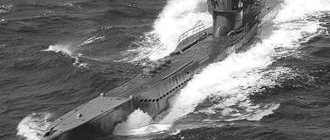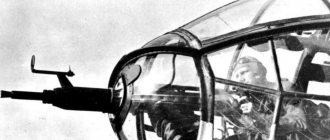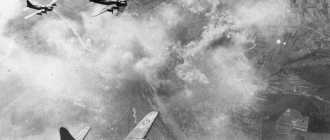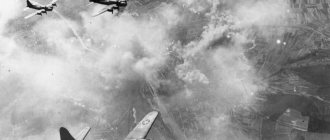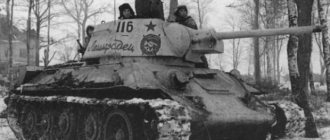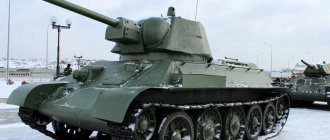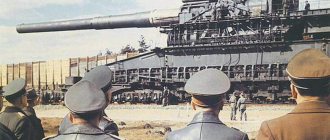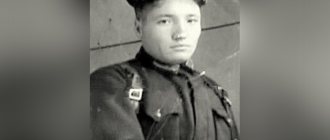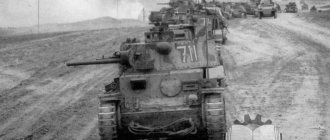Author: zaCCCPanec
12 July 2022 16:07
Community: Military
Tags: WWII aviation flying boats stories about weapons
4332
51
Not so noticeable, but cars that saved (or took) many lives.
0
See all photos in the gallery
When you bring up the question of flying boats, the person you're talking to is usually a little confused. The most that comes up is the Catalina. In general, only a few people know about our heroic “Barn,” but a separate material is being prepared about it. Well, of course, aviation enthusiasts and fans know about German boats. In fact, there were quite a lot of flying boats. Not as many as seaplanes, but still. They were there, they flew, they made their contribution to that war. Therefore, raise the anchor and take off!
Beriev MBR-2 (USSR).
0
I’ll tell you briefly about the legendary “barn”, because a long article is ahead. Unfortunately, this plane became obsolete long before the start of World War II, but alas, it flew from the first to the last day. This was Beriev’s debut aircraft, the beginning of a long journey for the entire Beriev Design Bureau. For the vehicle, the design of a single-engine cantilever monoplane and a two-jet boat with a large transverse deadrise was chosen.
×
0
The choice was not accidental; the MBR-2 had good seaworthiness for those times and could take off and land on the water in waves up to a meter high. The M-27 engine was planned as the power plant, but as we usually did with engines in those days, the MBR-2 went into production with completely different engines, the weaker M-17 and AM-34NB. It was assumed that the MBR-2 would have an all-metal structure, but Beriev, assessing the situation with aluminum production in the country, made the aircraft wooden and as simple as possible. Moreover, the aircraft turned out to be very technologically advanced; 3 months passed from the moment of laying down to the flight.
0
It was worse with the reconnaissance equipment. Many MBR-2s were surrendered without radios and aerial cameras, which were sent and installed in units. There were a lot of shortcomings. More on them at the end, but I wanted to mention one. From the front shooting point, aimed shooting was possible only up to a speed of 200 km/h; beyond that, the air flow simply did not allow the shooter to work normally, pressing him against the rear wall of the cabin. It turned out that at a speed above 200 km/h the plane was completely defenseless in the forward hemisphere.
0
In general, “barns” were the desired prey of German fighters in all coastal areas. Minimum stress – and another victory in your pocket. The plane was extremely defenseless. These simple but reliable flying boats became the main seaplanes of Soviet naval aviation at the beginning of the war. By that time, the MBR-2s were well mastered by the crews of combat units, receiving the ironic and affectionate nickname “barn” for their angular shapes.
0
The flying boats were durable and reliable, simple and pleasant to pilot, had good seaworthiness and did not cause much trouble to the pilots. The simple wooden structure allowed the technical staff to carry out repairs of almost any degree of complexity directly in the parts. However, the tree required special care. After rolling the MBR-2 ashore, the boat had to be thoroughly dried, for which a variety of methods were used: hot sand poured into covers, which was applied to damp parts of the aircraft, electric lamps, hot compressed air or cans of hot water. And these, already thoroughly outdated aircraft, had to carry the load of the main sea aircraft. Moreover, it is no longer a reconnaissance vehicle, but actually a multi-purpose vehicle.
0
MBR-2, in addition to reconnaissance and aerial photography, searched for and bombed submarines, attacked enemy ships and ports, took out the wounded, searched for their ships (the same PQ-17), covered their ships (this was generally nonsense, so the Black Sea Fleet lost half of its crews ). Sometimes there were completely non-standard tasks.
0
In September 1944, MBR-2 had to evacuate the crew of the English Lancaster, which took part in an air raid on the battleship Tirpitz. When flying from the target to the Yagodnik airfield near Arkhangelsk, the crew did not reach the refueling point and landed their plane on its “belly” right in a swamp near the village of Talagi. To get the British out of this wilderness, they had to parachute a guide, who led them to the nearest lake, where the MBR-2 was waiting.
0
On October 20 of the same 1944, a German seaplane BV.138 made an emergency landing in the area of the island. Morzhovets. The Germans began to call their own by radio, but the work of an unknown radio station attracted the attention of our sailors. MBR-2, which flew into that area, discovered its unlucky colleagues and aimed the hydrographic vessel “Mist” at BV.138, which captured both the plane and the crew. Advantages: cheap, technologically advanced, multi-purpose. Disadvantages: speed, weapons, need to dry out after each flight.
Weapons of World War II. flying boats
Not so noticeable, but cars that saved (or took) many lives.
When you bring up the question of flying boats, the person you're talking to is usually a little confused. The most that comes up is the Catalina. In general, only a few people know about our heroic “Barn,” but a separate material is being prepared about it. Well, of course, aviation enthusiasts and fans know about German boats.
In fact, there were quite a lot of flying boats. Not as many as seaplanes, but still. They were there, they flew, they made their contribution to that war. Therefore, raise the anchor and take off!
Beriev MBR-2. USSR
I’ll tell you briefly about the legendary “barn”, because a long article is ahead.
Unfortunately, this plane became obsolete long before the start of World War II, but alas, it flew from the first to the last day. This was Beriev’s debut aircraft, the beginning of a long journey for the entire Beriev Design Bureau. For the vehicle, the design of a single-engine cantilever monoplane and a two-jet boat with a large transverse deadrise was chosen.
The choice was not accidental; the MBR-2 had good seaworthiness for those times and could take off and land on the water in waves up to a meter high. The M-27 engine was planned as the power plant, but as we usually did with engines in those days, the MBR-2 went into production with completely different engines, the weaker M-17 and AM-34NB.
It was assumed that the MBR-2 would have an all-metal structure, but Beriev, assessing the situation with aluminum production in the country, made the aircraft wooden and as simple as possible. Moreover, the aircraft turned out to be very technologically advanced; 3 months passed from the moment of laying down to the flight.
It was worse with the reconnaissance equipment. Many MBR-2s were surrendered without radios and aerial cameras, which were sent and installed in units.
There were a lot of shortcomings. More on them at the end, but I wanted to mention one. From the front shooting point, aimed shooting was possible only up to a speed of 200 km/h; beyond that, the air flow simply did not allow the shooter to work normally, pressing him against the rear wall of the cabin. It turned out that at a speed above 200 km/h the plane was completely defenseless in the forward hemisphere.
In general, “barns” were the desired prey of German fighters in all coastal areas. Minimum stress – and another victory in your pocket. The plane was extremely defenseless.
These simple but reliable flying boats became the main seaplanes of Soviet naval aviation at the beginning of the war. By that time, the MBR-2s were well mastered by the crews of combat units, receiving the ironic and affectionate nickname “barn” for their angular shapes.
The flying boats were durable and reliable, simple and pleasant to pilot, had good seaworthiness and did not cause much trouble to the pilots. The simple wooden structure allowed the technical staff to carry out repairs of almost any degree of complexity directly in the parts. However, the tree required special care. After rolling the MBR-2 ashore, the boat had to be thoroughly dried, for which a variety of methods were used: hot sand poured into covers, which was applied to damp parts of the aircraft, electric lamps, hot compressed air or cans of hot water.
And these, already thoroughly outdated aircraft, had to carry the load of the main sea aircraft. Moreover, it is no longer a reconnaissance vehicle, but actually a multi-purpose vehicle.
MBR-2, in addition to reconnaissance and aerial photography, searched for and bombed submarines, attacked enemy ships and ports, took out the wounded, searched for their ships (the same PQ-17), covered their ships (this was generally nonsense, so the Black Sea Fleet lost half of its crews ).
Sometimes there were completely non-standard tasks.
In September 1944, MBR-2 had to evacuate the crew of the English Lancaster, which took part in an air raid on the battleship Tirpitz. When flying from the target to the Yagodnik airfield near Arkhangelsk, the crew did not reach the refueling point and landed their plane on its “belly” right in a swamp near the village of Talagi.
To get the British out of this wilderness, they had to parachute a guide, who led them to the nearest lake, where the MBR-2 was waiting.
On October 20 of the same 1944, a German seaplane BV.138 made an emergency landing in the area of the island. Morzhovets. The Germans began to call their own by radio, but the work of an unknown radio station attracted the attention of our sailors. MBR-2, which flew into that area, discovered its unlucky colleagues and aimed the hydrographic vessel “Mist” at BV.138, which captured both the plane and the crew.
Advantages: cheap, technologically advanced, multi-purpose.
Disadvantages: speed, weapons, need to dry out after each flight.
Consolidated PBY Catalina. USA
There is no doubt that the PBY Catalina was a very successful flying boat. One of the best. Produced continuously for ten years, it became the most popular seaplane in the world.
Incredibly, of the 3,300 Catalinas produced (built in flying boat and amphibious versions), about a hundred continue to fly today.
The PBY flying boat was named "Catalina" in Great Britain in November 1940, shortly after the Royal Air Force received the first of these machines, which were subsequently purchased in large quantities.
The plane was named after the resort island located off the coast of California. The name "Catalina" fully complied with the RAF naming system for foreign aircraft. When the United States officially introduced a naming system for its aircraft in 1941, it borrowed many names from the British, including Catalina.
PBY in the flying boat version, built by the Canadians for their Air Force (RCAF), received the designation CANSO, and in the amphibious version CANSO-A. Another little-known name for this aircraft was “Nomad” (Nomad - nomad).
In general, by the beginning of the war, so many Catalinas had been produced by order of the US Navy that the boat became the main seaplane of the American fleet.
Naturally, as soon as hostilities against Japan began, the Catalina was called up for service. The flying boat had to try on the role of a multi-role aircraft with a wide range of operations, since the range of the PBY-4 was simply luxurious.
However, the first clashes between Catalinas and Japanese aircraft revealed the vulnerability of American flying boats. The lack of armor protection for the crew and protected fuel tanks made them relatively easy prey for the Japanese.
The few surviving accounts of attacks on PBY groups never mention the Americans attempting to maintain formation and mutually support each other with fire.
And the point here was not the lack of experience of the American pilots; everything was fine with this. The plane had a different problem: a very unfortunate location of the shooting points. Plus magazine feed for Browning heavy machine guns. Japanese pilots, through the huge blisters, could clearly see when the shooter began to change the magazine and learned to take advantage of the moment, mowing down the shooters.
Plus, the Catalin pilots had no view of the rear hemisphere at all.
In general, both bombers and torpedo bombers, the Catalinas ended very quickly.
But the rescue Catalinas have become a symbol of life for the crews of downed planes, sunken ships and ships. The rescue effort was codenamed “Dumbo,” after the flying baby elephant from the Walt Disney cartoon. At first, this name was used in radio communications, but then it became firmly established among rescuers.
It got to the point that during the Solomon Islands campaign, Catalinas were assigned to assist strike groups, patrolling in an area near the target.
PBY-4 also worked in the Russian north as a scout and rescuer. In addition, there was the Soviet Catalina, also known as GST (Hydro Airplane Transport), manufactured in Taganrog under license, but not with conventional engines, but licensed Wright Cyclones.
Advantages: load capacity, versatility, range
Disadvantages: visibility, poor placement of weapons
Short S.25 Sunderland. Great Britain
The coolest British sea lion.
You can, of course, argue in terms of who was more effective, Sunderland or Valrus, but the weight categories are different, and the guys at Sunderland did more things. So, such a hefty flying boat. The boat here is somehow out of weight category.
It’s worth saying here that Sunderland was created on the basis of the already well-proven S.23 Empire mail and passenger aircraft. That is, we can say that a civilian aircraft was called up for military service and adapted to the conditions of military life.
In fact, the mail plane made an excellent patrol plane. Not surprisingly, this boat already had all the necessary qualities: a large double-deck fuselage, thanks to which a long flight range was combined with good habitability conditions.
Not only could the plane take a lot of fuel, but it also had simply magical conditions for the crew: on board there was a galley, a dining room and a sleeping compartment with six beds. It’s no wonder that envious people gave this plane the nickname “flying hotel.”
Overall: long flight duration, excellent conditions for the crew, fairly good maneuverability for such a large vehicle, good visibility and the ability not to skimp on every kilogram of ammunition - all these components made the Sunderland an excellent anti-submarine patrol aircraft.
Sunderland had one very funny feature. The front rifle turret could slide backward along the rails, into the fuselage. At the same time, at the bow end of the boat, something like a small deck with a fence was formed, from which it was convenient to moor.
Just a few words about weapons. A mountain of 7.7-mm machine guns was, of course, a good thing, but as the war progressed, rifle-caliber Vickers were gradually replaced by large-caliber Brownings, which played a very positive role.
In general, Sunderland was a very difficult target, and both the Germans and Italians did not rub their hands joyfully at the sight of this car. The S.25 could easily fight off anyone; another question is that not everyone was eager to fly as far from land as the Sunderland pilots did.
The S.25's combat record was opened on September 17, 1940, when one of the aircraft of the 228th AE shot down the Italian flying boat Kant Z.501.
With bombs it turned out to be more difficult. In general, the load in numbers looks very modest, and it is clear that such an aircraft could take on board much more. British engineers categorically did not want to compromise the strength of the boat’s bottom and its tightness. That’s why they made bomb bays... in the sides!
The bombs were pulled out through hatches in the fuselage under the wing using electric drives and dropped there. Then the drive rods were retracted for new bombs. Peculiar, but justified.
Naturally, the Sunderland performed very well as a transport seaplane. More precisely, a tow truck. For example, of the 28,000 British people evacuated from Crete, 14,500 were taken out by these flying boats.
But the main combat mission for the Sunderlands was patrolling sea and ocean waters in search of enemy submarines. And in this the S.25 more than succeeded.
And the appearance in 1943 of the new ASV Mk.III anti-submarine radar allowed anti-submarine aircraft to move from escorting convoys to offensive tactics, that is, to attempts to find and intercept enemy submarines before they entered combat deployment areas.
In total, the Sunderlands destroyed 26 German U-bots (21 of them on their own). It’s difficult to say how many attacks were thwarted by the mere presence of S.25 in the convoy’s movement area. The fact is that the German submarines, which had radar signaling equipment on board, were in no hurry to launch an attack.
And the S.25 served for a very long time. They carried mail in Argentina until 1967, and the record belongs to a former Australian seaplane that flew in French Polynesia back in 1970.
Advantages: seaworthiness, weapons, conditions for the crew, flight duration
Disadvantages: perhaps only a technically complex bomb release system.
CANT Z.501 Gabbiano. Italy
The Italian “Chaika” somehow repeated the fate of its Soviet land namesake. That is, it was completely and irrevocably outdated by the beginning of the war and was actually knocked out by enemy fighters, because it really couldn’t oppose anything to them.
Nevertheless, the plane fought the entire war, from the first to the last (for Italy) day.
Before the start of World War II, the Italian fleet had more than 200 Z.501 aircraft at its disposal. The configurations are different, which is quite normal for a flying boat. These include reconnaissance aircraft, bombers, and tow trucks. There were even attempts to adapt the Z.501 to search and destroy enemy submarines, but somehow it didn’t work out.
In general, the aircraft was uncharacteristic for the Italian aircraft industry. On the one hand, a beautiful body, narrow and dynamic, on the other, a huge awkward wing plopped on top. But this disharmony worked quite well, the machine flew well for its time.
But the boat was often called not “Gabbiano”, but “Mamayuto”, “Oh, Mommy!” According to legend, this is what a child shouted when he saw this plane for the first time. Whether it’s true or not is hard to say.
But the combat effectiveness was very low. And the reason for this was not aerohydrodynamics, but mainly the low survivability and low reliability of the engines. The armament also left much to be desired, but for lack of anything better, the Seagulls flew over the waves until the end of the war.
After the surrender, only 30 seaplanes remained in Italian aviation. By May 1944, their number was reduced to 24 - the rest remained in Nazi-occupied Northern Italy.
But the surviving aircraft flew until 1950. Not ideal, but still.
Advantages: released in a large series
Disadvantages: maneuverability, reliability, speed, weapons.
Latecoere Loire 130. France
It is with a little regret that I note that the most common French flying boat during the war years was the Loire 130 monoplane.
It was built according to the design as an ejection reconnaissance aircraft. Accordingly, small and light. There were more significant cars in France, but they were produced in completely tiny series, from 1 to 10 cars. So, no matter how much they wanted, they could not have any influence on the course of hostilities.
The Loire 130 flying boats started the Second World War on all French ships that had catapults. From battleship to floating base. Plus patrol squadrons within the Air Force.
After November 1942, all French warships lost their catapults, which were removed in order to accommodate more anti-aircraft guns. All Loire 130 boats ended up “onshore”, that is, they began to be used from a coastal base.
Naturally, they were first used as patrol aircraft to detect and hunt submarines. Another question is what two 75 kg bombs could do.
The aircraft were most actively used in Vichy aviation. Moreover, they fought, as is typical for French aircraft, on both sides of the front. The Loires that remained in the Vichy Air Force could easily fight the Loires that flew to the British from Tunisia, Lebanon and Martinique.
In general, the Loire 130 became the most popular French flying boat of the Second World War. Despite its low speed qualities, it was distinguished by its reliability, ease of operation and flexibility of use.
Moreover, in reality, this airplane was very multifunctional. The vehicle was truly multi-purpose, it could take off from coastal and coastal bases, and from ship catapults. The Loire 130 could be used as a reconnaissance, transport, search and rescue aircraft.
Advantages: simple, manageable, reliable.
Disadvantages: speed, weapons.
Blohm und Voss BV.138. Germany
This boat can be safely placed on a par with the best representatives of this class of aircraft, since not everyone could do what the BV.138 could do.
Good seaworthiness, which made it possible to take off and land in waves greater than 1 meter, and excellent flight range, showed that the V.138 was an outstanding aircraft for its time. Not only did the BV.138 prove to be an excellent patrol aircraft, extremely durable, not afraid of either waves or machine guns, but its outstanding seaworthiness, coupled with the ability to stay on the open sea for a long time, allowed it to be used in a way that no other aircraft had ever been used before. plane of that war: from an ambush.
It was done like this: BV.138 flew into the Atlantic, landed on the water and drifted for two or three days until the announcement of the passage of an Allied convoy. After this, BV.138 took off and directed submarines at the convoy. He could have attacked himself, but targeting a “wolf pack” with one plane was much more lethal than several bombs or a torpedo.
The designers were able to make it so that even quite complex repairs could be carried out on the open sea. And they refueled the BV.138 from submarines easily and naturally, if the weather permitted.
With a maximum fuel supply, the VV.138 could stay in the air for up to 18 hours, although with a normal fuel supply it was only 6.5.
The Arctic, the Baltic, and the Atlantic became the field of action for the BV.138. Wherever eyes and clear guidance of other forces were needed.
In the north, in 1942, the Germans concentrated 44 BV.138 units in Norway; in fact, not a single convoy could pass unnoticed. ВV.138. In this way, effective detection and subsequent tracking of convoys was ensured. It is worth noting that losses from air defense actions of convoy ships were small.
True, almost immediately the Allies began to include aircraft carriers in the convoys, whose aircraft somewhat complicated the work of German reconnaissance officers. However, even in this case, it was not easy to neutralize the operation of VV.138. There was a recorded case where a flying boat survived a 90-minute battle with Sea Hurricanes and managed to return to base, albeit with serious damage.
The firing sectors of the guns were too well distributed, which could cause damage to enemy fighters due to the range of the latter’s machine guns. There were also cases of BV.138 attacks on escort aircraft, especially seaplanes.
By 1942, the insolent Germans created bases for the BV.138 on Soviet territory, on Novaya Zemlya. The base was organized from submarines; it was assumed that the planes would conduct reconnaissance of convoys in the Kara Sea, operating from Novaya Zemlya. From this base, BV.138 carried out reconnaissance flights east to Yamal and to the north of the eastern part of the Urals for several weeks.
Of course, by the end of the war, the use of rather leisurely flying boats in conditions of complete enemy air superiority became an extremely risky business. But in the Arctic, VV.138 operated until the very end of the war.
And the BV.138 became the aircraft that wrote one of the last lines in the history of the Luftwaffe. It was Lieutenant Wolfgang Klemusch, who was flying this machine, who received the order on May 1, 1945 to fly on his BV.138 to Berlin at night, land on the lake and pick up two very important couriers. Klemush landed successfully despite intense shelling, but since the couriers were unable to provide any identification documents, the pilot refused to take them on board, but loaded 10 wounded and returned to Copenhagen.
It subsequently turned out that these couriers were supposed to deliver Hitler's will and will.
In general, the aircraft turned out to be very functional and multifaceted, which is why it was able to fight the entire war.
Advantages: strength, seaworthiness, weapons, flight duration
Disadvantages: maneuverability and speed.
Kawanishi H8K. Japan
The creation of this monster began long before World War II, but had to go through a number of models to produce one of the best flying boats. Without any exaggeration, N8K can be assessed in exactly this way.
In general, the Japanese have created a lot of things that do not fit into the global canons. Especially when they were pressed by the Washington Treaty, strange inventions began to fall like an avalanche.
And all these inventions were not subject to contractual restrictions, since they really had no class. These are super destroyers, and huge oxygen torpedoes “long lances” for them, patrol submarines-aircraft carriers, heavy cruisers and battleships, high-speed seaplane carriers carrying dwarf submarines, huge minelayers, torpedo cruisers (with 40 torpedo tubes each) and other useful things .
But, perhaps, the closest attention was paid to a new type of naval weapons - carrier-based, coastal aviation and seaplanes.
Japan did enter the war with the world's best carrier-based fighters, dive bombers and torpedo bombers. The coastal aviation of the fleet received torpedo bombers with simply fantastic range, and heavy attack and reconnaissance flying boats conducted strategic reconnaissance throughout the Pacific Ocean.
This luxurious device was created on. It's funny, but the lion's share of the shares belonged to the British company Short Brothers, albeit in a somewhat veiled form. And Short Brothers was a gentle and reliable supplier to the Navy of Her Majesty the Queen of Great Britain.
Nothing personal, just business: the Japanese got access to the latest achievements of the English hydroaircraft industry, and Short Brothers did not pay taxes on the sale of licenses to Japan, so the similarity of the concepts and some technical solutions of the H8K and Sunderland is not surprising.
But I have already told you what Japanese engineers created from foreign-made samples (cannons and machine guns), and what masterpieces they produced. It worked this time too.
The performance characteristics given at the end of the article immediately place the aircraft in the category of perfect ones.
Its outstanding parameters immediately placed the boat in the category of strategic reconnaissance aircraft. But at the same time it was also a very toothy aircraft, capable of delivering serious blows.
Two of these flying boats took part in a little-known but unique operation - the second strike on Pearl Harbor. The purpose of the operation was defined as reconnaissance of the harbor and bombing of the oil storage facility of the main base of the American fleet, which was practically not damaged during the aircraft carrier raid of Vice Admiral Nagumo Chuichi.
The crews of Lieutenants Hashizumi and Tomano from the Yokohama Air Corps, with four 250-kg bombs on each vehicle, flew from Wotje Atoll to the French Frigate Reefs north of the Hawaiian Islands, where they refueled from submarines and continued their flight to Pearl Harbor.
Bad weather over the target forced the Japanese to bomb through the clouds, so it is not surprising that there was no result. The second attempt to carry out this operation ended in the death of the crew of Lieutenant Tomano during additional reconnaissance of the target - he was shot down by fighters, and soon the American fleet took control of the French Frigate reefs.
The capabilities of the boats were constantly improved. The N8K aircraft were among the first in the history of Japanese aircraft manufacturing to receive multi-layer rubber protection for their fuel tanks, and the seats of the pilots and commander of the ship received armored backrests.
The plane fought throughout the war. N8Ks were engaged in reconnaissance in the Pacific and Indian oceans, bombed Colombo, Calcutta, Trincomalee and targets in Western Australia, supplied island garrisons isolated in the ocean, searched for and sank submarines.
To do this, search radars were installed on a small number of N8Ks in 1944. The effect was, no less than seven American submarines went to the bottom with the direct “assistance” of Japanese flying boats.
And the N8K was recognized as a very tough nut to crack for fighter aircraft. Simply insane survivability, coupled with powerful defensive weapons and the fanaticism of the Japanese crews, claimed the lives of more than one American and British pilot who tried to destroy the plane. It happened that in order to make the N8K fall, 5-6 fighters used up all their ammunition.
But at the second stage of the war, the Allies had plenty of fighters and ammunition, so that by the time Japan surrendered, only two flying boats of this type survived. All seaplanes of the L transport modification were also destroyed.
By the way, it was the N8K that took part in one of the sad episodes of the imperial fleet.
In April 1943, American pilots shot down two G4M1 bombers, which killed several officers of the United Fleet headquarters, led by the commander in chief, Admiral Yamamoto Isoroku. The Japanese Navy command decided to provide more reliable “bullet-proof” aircraft. The choice fell on the H8K flying boat. By the fall, the first aircraft was modernized, designated H8K1-L m.31. A sort of VIP option, capable of comfortably carrying 29 passengers in addition to the crew.
These were reliable vehicles that did not cause any complaints either from the crews or from the passengers, but for the second time the headquarters of the United Fleet was lost along with the new commander, Vice Admiral Koga Mineichi, precisely on board the H8K2-L. In 1944, the commander-in-chief's plane was caught in a typhoon while flying from the Palau Islands to Davao and went missing.
Advantages: reliability, speed, weapons, range, seaworthiness.
Disadvantages: perhaps none.
Of course, flying boats were not as common as fighters and bombers, but they contributed to the victory of one side or another. The only question is who is better.
Consolidated PBY Catalina (USA).
0
There is no doubt that the PBY Catalina was a very successful flying boat. One of the best. Produced continuously for ten years, it became the most popular seaplane in the world. Incredibly, of the 3,300 Catalinas produced (built in flying boat and amphibious versions), about a hundred continue to fly today.
0
The PBY flying boat was named "Catalina" in Great Britain in November 1940, shortly after the Royal Air Force received the first of these machines, which were subsequently purchased in large quantities. The plane was named after the resort island located off the coast of California. The name "Catalina" fully complied with the RAF naming system for foreign aircraft. When the United States officially introduced a naming system for its aircraft in 1941, it borrowed many names from the British, including Catalina.
0
PBY in the flying boat version, built by the Canadians for their Air Force (RCAF), received the designation CANSO, and in the amphibious version CANSO-A. Another little-known name for this aircraft was “Nomad” (Nomad - nomad). In general, by the beginning of the war, so many Catalinas had been produced by order of the US Navy that the boat became the main seaplane of the American fleet.
0
Naturally, as soon as hostilities against Japan began, the Catalina was called up for service. The flying boat had to try on the role of a multi-role aircraft with a wide range of operations, since the range of the PBY-4 was simply luxurious. However, the first clashes between Catalinas and Japanese aircraft revealed the vulnerability of American flying boats. The lack of armor protection for the crew and protected fuel tanks made them relatively easy prey for the Japanese.
0
The few surviving accounts of attacks on PBY groups never mention the Americans attempting to maintain formation and mutually support each other with fire. And the point here was not the lack of experience of the American pilots; everything was fine with this. The plane had a different problem: a very unfortunate location of the shooting points. Plus magazine feed for Browning heavy machine guns. Japanese pilots, through the huge blisters, could clearly see when the shooter began to change the magazine and learned to take advantage of the moment, mowing down the shooters.
0
Plus, the Catalin pilots had no view of the rear hemisphere at all. In general, both bombers and torpedo bombers, the Catalinas ended very quickly. But the rescue Catalinas have become a symbol of life for the crews of downed planes, sunken ships and ships. The rescue effort was codenamed “Dumbo,” after the flying baby elephant from the Walt Disney cartoon. At first, this name was used in radio communications, but then it became firmly established among rescuers.
0
It got to the point that during the Solomon Islands campaign, Catalinas were assigned to assist strike groups, patrolling in an area near the target. PBY-4 also worked in the Russian north as a scout and rescuer. In addition, there was the Soviet Catalina, also known as GST (Hydro Airplane Transport), manufactured in Taganrog under license, but not with conventional engines, but licensed Wright Cyclones. Advantages: load capacity, versatility, range Disadvantages: visibility, poor weapon placement
Between two elements
Urgent dive: how the domestic submarine fleet began
What role did orchids play in the fate of the first Russian submarines?
At the dawn of aviation, pilots noticed strange behavior of the machines when landing: when there were only a few meters left to the ground, the rate of descent dropped sharply and the plane began to be pushed away from the surface. After some time, the situation that led to frequent accidents was explained by scientists - it turned out that near the surface the aerodynamic properties of the wing change due to the fact that the air waves going down have time to be reflected from the ground and, upon returning, seem to push the car up.
The phenomenon was called the “screen effect”, and pretty soon the idea of creating an aircraft using this phenomenon appeared. The smooth surface of the oceans and seas that cover the planet also suggested the area of application of such a machine. The advantages were obvious - the ekranoplan could combine the best features of a ship and an airplane. From the first, he took greater carrying capacity and safety, because the flight was directly over the water and the car could always land on the water - it was enough to turn off the engines. And its speed was comparable to that of an airplane, since the ekranoplane did not come into contact with water (or any other surface) and did not experience its resistance.
Sea monsters
Marine ekranoplan "Eaglet"
Photo: TASS/Alexey Zhigailov
Research was carried out in different countries, but it turned out that, in addition to the undeniable positive qualities, the new means of transportation strove to grab a whole heap of their “sores” from their sea and celestial relatives, and intensifying them many times over. The problem was that to create an ekranoplan, engineers had to possess both the skills of an aircraft designer and a shipbuilder, and such “uniques” were not easy to find. But it turned out that they still existed.
Big trunks: how Russia got its own dreadnoughts
Why Stolypin advocated the construction of battleships of the Sevastopol class
Short S.25 Sunderland (UK).
0
The coolest British sea lion. You can, of course, argue in terms of who was more effective, Sunderland or Valrus, but the weight categories are different, and the guys at Sunderland did more things. So, such a hefty flying boat. The boat here is somehow out of weight category.
0
It’s worth saying here that Sunderland was created on the basis of the already well-proven S.23 Empire mail and passenger aircraft. That is, we can say that a civilian aircraft was called up for military service and adapted to the conditions of military life. In fact, the mail plane made an excellent patrol plane. Not surprisingly, this boat already had all the necessary qualities: a large double-deck fuselage, thanks to which a long flight range was combined with good habitability conditions.
0
Not only could the plane take a lot of fuel, but it also had simply magical conditions for the crew: on board there was a galley, a dining room and a sleeping compartment with six beds. It’s no wonder that envious people gave this plane the nickname “flying hotel.” Overall: long flight duration, excellent conditions for the crew, fairly good maneuverability for such a large vehicle, good visibility and the ability not to skimp on every kilogram of ammunition - all these components made the Sunderland an excellent anti-submarine patrol aircraft.
0
Sunderland had one very funny feature. The front rifle turret could slide backward along the rails, into the fuselage. At the same time, at the bow end of the boat, something like a small deck with a fence was formed, from which it was convenient to moor. Just a few words about weapons. A mountain of 7.7-mm machine guns was, of course, a good thing, but as the war progressed, rifle-caliber Vickers were gradually replaced by large-caliber Brownings, which played a very positive role.
0
In general, Sunderland was a very difficult target, and both the Germans and Italians did not rub their hands joyfully at the sight of this car. The S.25 could easily fight off anyone; another question is that not everyone was eager to fly as far from land as the Sunderland pilots did. The S.25's combat record was opened on September 17, 1940, when one of the aircraft of the 228th AE shot down the Italian flying boat Kant Z.501.
0
With bombs it turned out to be more difficult. In general, the load in numbers looks very modest, and it is clear that such an aircraft could take on board much more. British engineers categorically did not want to compromise the strength of the boat’s bottom and its tightness. That’s why they made bomb bays... in the sides! The bombs were pulled out through hatches in the fuselage under the wing using electric drives and dropped there. Then the drive rods were retracted for new bombs. Peculiar, but justified.
0
Naturally, the Sunderland performed very well as a transport seaplane. More precisely, a tow truck. For example, of the 28,000 British people evacuated from Crete, 14,500 were taken out by these flying boats. But the main combat mission for the Sunderlands was patrolling sea and ocean waters in search of enemy submarines. And in this the S.25 more than succeeded.
0
And the appearance in 1943 of the new ASV Mk.III anti-submarine radar allowed anti-submarine aircraft to move from escorting convoys to offensive tactics, that is, to attempts to find and intercept enemy submarines before they entered combat deployment areas. In total, the Sunderlands destroyed 26 German U-bots (21 of them on their own). It’s difficult to say how many attacks were thwarted by the mere presence of S.25 in the convoy’s movement area. The fact is that the German submarines, which had radar signaling equipment on board, were in no hurry to launch an attack.
0
And the S.25 served for a very long time. They carried mail in Argentina until 1967, and the record belongs to a former Australian seaplane that flew in French Polynesia back in 1970. Advantages: seaworthiness, weapons, conditions for the crew, flight duration Disadvantages: perhaps only a technically complex bomb release system.
CANT Z.501 Gabbiano (Italy)
0
The Italian “Chaika” somehow repeated the fate of its Soviet land namesake. That is, it was completely and irrevocably outdated by the beginning of the war and was actually knocked out by enemy fighters, because it really couldn’t oppose anything to them. Nevertheless, the plane fought the entire war, from the first to the last (for Italy) day.
0
Before the start of World War II, the Italian fleet had more than 200 Z.501 aircraft at its disposal. The configurations are different, which is quite normal for a flying boat. These include reconnaissance aircraft, bombers, and tow trucks. There were even attempts to adapt the Z.501 to search and destroy enemy submarines, but somehow it didn’t work out. In general, the aircraft was uncharacteristic for the Italian aircraft industry. On the one hand, a beautiful body, narrow and dynamic, on the other, a huge awkward wing plopped on top. But this disharmony worked quite well, the machine flew well for its time.
0
But the boat was often called not “Gabbiano”, but “Mamayuto”, “Oh, Mommy!” According to legend, this is what a child shouted when he saw this plane for the first time. Whether it’s true or not is hard to say. But the combat effectiveness was very low. And the reason for this was not aerohydrodynamics, but mainly the low survivability and low reliability of the engines. The armament also left much to be desired, but for lack of anything better, the Seagulls flew over the waves until the end of the war.
0
After the surrender, only 30 seaplanes remained in Italian aviation. By May 1944, their number was reduced to 24 - the rest remained in Nazi-occupied Northern Italy. But the surviving aircraft flew until 1950. Not ideal, but still. Advantages: released in a large series. Disadvantages: maneuverability, reliability, speed, weapons.
Latecoere Loire 130 (France).
0
It is with a little regret that I note that the most common French flying boat during the war years was the Loire 130 monoplane. It was built according to the design as an ejection reconnaissance aircraft. Accordingly, small and light. There were more significant cars in France, but they were produced in completely tiny series, from 1 to 10 cars. So, no matter how much they wanted, they could not have any influence on the course of hostilities.
0
The Loire 130 flying boats started the Second World War on all French ships that had catapults. From battleship to floating base. Plus patrol squadrons within the Air Force. After November 1942, all French warships lost their catapults, which were removed in order to accommodate more anti-aircraft guns. All Loire 130 boats ended up “onshore”, that is, they began to be used from a coastal base.
0
Naturally, they were first used as patrol aircraft to detect and hunt submarines. Another question is what two 75 kg bombs could do. The aircraft were most actively used in Vichy aviation. Moreover, they fought, as is typical for French aircraft, on both sides of the front. The Loires that remained in the Vichy Air Force could easily fight the Loires that flew to the British from Tunisia, Lebanon and Martinique.
0
In general, the Loire 130 became the most popular French flying boat of the Second World War. Despite its low speed qualities, it was distinguished by its reliability, ease of operation and flexibility of use. Moreover, in reality, this airplane was very multifunctional. The vehicle was truly multi-purpose, it could take off from coastal and coastal bases, and from ship catapults. The Loire 130 could be used as a reconnaissance, transport, search and rescue aircraft. Advantages: simple, manageable, reliable. Disadvantages: speed, weapons.
Blohm und Voss BV.138 (Germany).
0
This boat can be safely placed on a par with the best representatives of this class of aircraft, since not everyone could do what the BV.138 could do. Good seaworthiness, which made it possible to take off and land in waves greater than 1 meter, and excellent flight range, showed that the V.138 was an outstanding aircraft for its time. Not only did the BV.138 prove to be an excellent patrol aircraft, extremely durable, not afraid of either waves or machine guns, but its outstanding seaworthiness, coupled with the ability to stay on the open sea for a long time, allowed it to be used in a way that no other aircraft had ever been used before. plane of that war: from an ambush.
0
It was done like this: BV.138 flew into the Atlantic, landed on the water and drifted for two or three days until the announcement of the passage of an Allied convoy. After this, BV.138 took off and directed submarines at the convoy. He could have attacked himself, but targeting a “wolf pack” with one plane was much more deadly, several bombs or a torpedo for weeks. The designers were able to make it so that even quite complex repairs could be carried out on the open sea. And they refueled the BV.138 from submarines easily and naturally, if the weather permitted.
0
With a maximum fuel supply, the VV.138 could stay in the air for up to 18 hours, although with a normal fuel supply it was only 6.5. The Arctic, the Baltic, and the Atlantic became the field of action for the BV.138. Wherever eyes and clear guidance of other forces were needed.
0
In the north, in 1942, the Germans concentrated 44 BV.138 units in Norway; in fact, not a single convoy could pass unnoticed. ВV.138. In this way, effective detection and subsequent tracking of convoys was ensured. It is worth noting that losses from air defense actions of convoy ships were small. True, almost immediately the Allies began to include aircraft carriers in the convoys, whose aircraft somewhat complicated the work of German reconnaissance officers. However, even in this case, it was not easy to neutralize the operation of VV.138. There was a recorded case where a flying boat survived a 90-minute battle with Sea Hurricanes and managed to return to base, albeit with serious damage.
0
The firing sectors of the guns were too well distributed, which could cause damage to enemy fighters due to the range of the latter’s machine guns. There were also cases of BV.138 attacks on escort aircraft, especially seaplanes. By 1942, the insolent Germans created bases for the BV.138 on Soviet territory, on Novaya Zemlya. The base was organized from submarines; it was assumed that the planes would conduct reconnaissance of convoys in the Kara Sea, operating from Novaya Zemlya. From this base, BV.138 carried out reconnaissance flights east to Yamal and to the north of the eastern part of the Urals for several weeks.
0
Of course, by the end of the war, the use of rather leisurely flying boats in conditions of complete enemy air superiority became an extremely risky business. But in the Arctic, VV.138 operated until the very end of the war. And the BV.138 became the aircraft that wrote one of the last lines in the history of the Luftwaffe. It was Lieutenant Wolfgang Klemusch, who was flying this machine, who received the order on May 1, 1945 to fly on his BV.138 to Berlin at night, land on the lake and pick up two very important couriers. Klemush landed successfully despite intense shelling, but since the couriers were unable to provide any identification documents, the pilot refused to take them on board, but loaded 10 wounded and returned to Copenhagen.
0
It subsequently turned out that these couriers were supposed to deliver Hitler's will and will. In general, the aircraft turned out to be very functional and multifaceted, which is why it was able to fight the entire war. Advantages: strength, seaworthiness, armament, flight duration. Disadvantages: maneuverability and speed.
pNYAYAH (yayap)YuBHYURKHY-YUKEMYAY Yukeya-251 KETSYKHI LMNTSNZHEKEBNI YAYULNKER-YULTHAKHyUMMEMYNB k-4 ketsykhi LMNTsNZHEKEBNI YAYULNKER-YULTHAKH yUMMEMYNB k-6 ketsykhi LMNTsNZHEKEBNI YAYULNKER-YULTKHAKHyushchPNbNKTSYu anpei ketsykhi LMNTsNZHEKEBNI YAYULNKER-YULTHAKH yushchPNbNKTsyu kyu-8 ketsykhi LMNTsNZHEKEBNI YYULNKER-YULTKHAKHyushchpnopntspeya r-130 tpetsyur ketsyhi LMNTsNZHEKEBNI YAYULNKER-YULTHAKHaYUYUMNB yayuay-1l KETSYYU KERYUCHYYU KNDYU-SHYPYUMNKER aEPHEB A-40 yukeayurpnya lMNTSNZHEKEBNI YAYULNKER-YULTHAKH aEPHEB A-42 onHYAYNBN-YAOYUYUREKEMSHI YAYULNKER-YULTKHAKH aEPHEB ae-12o vuyyu oPNRHBNONFYUPMSHI YAYULNKER-YUL THAHЪ aEPHEB ae-12o-200 vuyyu oPNRKHBNONFYUPMSHI YAYULNKER-YULTKHAKH aEPHEB ae-42 yukeayurpnya lMNTSNZHEKEBNI YAYULNKER-YULTHAKH aEPHEB ae -103 lMNTSNZHEKEBNI YAYULNKER-YULTHAKH aEPHEB ae-112 lMNTSNZHEKEBNI YAYULNKER-YULTHAKH aEPHEB ae-200 lMNTSNZHEKEBNI YAYULNKER-YULTKHAKH aEPHEB ae-200vya lMNTSNZHEKEBNI YAYULNKER-YULTHAKH aEPHEB ae-210 oYUYAYUFHPYAYKHI YAYULNKER-YULTKHAKHKYUOKYUM k-471 KETSYKHI LMNTsNZHEKEBNI YAYULNKER-YULTHAKH phdyu kyutsmyu kETSYKHI LMNTsNZHEKEBNI YAYULNKER-YULTKHAKH my yayus p-02 pnaepr kETSYKHI LMNTSNZHEKEBNI YAYULNKER-YULTKHAKH my yayus p-50 pnaepr ketsykhi LMNTsNZHEKEBNI YAYULNKER-YULTKHAKH n ya-kyu i-202 ketsykhi LMNTsNZHEKEBNI TsKHDPNYULNKER nya-kyu i-400 yuohryum kETSYKHI LMNTsNZHEKEBNI TsKHDPNYULNKERnPKHNM-YUBHYU yay-12 nPkhnm KETSYKHI LMNTsNZHEKEBNI YAYULNKER-YULTKHAKHYURYURSYA YUBHYU YAY-1 YURYURYA KETSYKHI LMNTSNZHEKEBNI YAYULNKER-YULTKHAKH upsmkhweb-yubkhyureumkhyu r-433 tkulkhmtsn ketsykhi LMNTsNZHEKEBNI YAYULNKER-YULTHAKHVYUIYU k-42 kETSYKHI LMNTsNZHEKEBNI YAYULNKER-YULTHAKH vYUYYU k-44 kETSYKHI LMNTsNZHEKEBNI YAYULNKER-YULTKHAKH vYUYYU k-72 ketsykhi LMNTsNZHEKEBNI YAYULNKER-YULTKHAKHvEPMNB, tsKhDPNOKYUM ve-22 ynpber lMNTSNZHEKEBNI TsKHDPNYULNKERVEPMNB, TsKHDPNYALNKER ve-23 KETSYKHI LMNTsNZHEKEBNI YAYULNKER-YULTHAKHVEPMNB, TsKHDPNYULNKER ve-24 KETSYKHI LMNTsNZHEKEBNI YAYULNKER-YULTHAKHvEPMNB ve-25 kETSYKHI LMNTsNZHEKEBNI TsKHDPNYULNKERVEPMNB, TsKHDPNYULNKER ve-27 KETSYKHI LMNTsNZHEKEBNI YAYULNKER-YULTHAKHVEPMNB, TsKHDPNYALNKER ve-28 kETSYKHI LMNTsNZHEKEBNI YAYULNKER-YULTHAKHVEPMNB, TsKHDPNYALNKER ve-29 KETSYKHI LMNTsNZHEKEBNI YAYULNKER-YULTHAKHSYPYUKHMYU YUSCHPNOPYUR yu-24 bhykhmts ketsykhi LMNTsNZHEKEBNI YAYULNKER-YULTHAKH
yayuAero Adventure AVENTURA KETSYKHI LMNTSNZHEKEBNI YAYULNKER-YULTHAKH Airmaster AVALON lMNTSNZHEKEBNI YAYULNKER-YULTHAKH
Ellison-Mahon GWEDUCK kETSYKHI LMNTsNZHEKEBNI YAYULNKER-YULTHAKHLake LA-250 RENEGADE KETSYKHI LMNTsNZHEKEBNI YYULNKER-YULTHAKH Lake SEAWOLF lMNTSNZHEKEBNI YAYULNKER-YULTHAKHPrivateer PRIVATEER KETSYKHI LMNTSNZHEKEBNI YAYULNKER-YULTHAKH Progressive Aerodyne SEAREY KETSYKHI LMNTSNZHEKEBNI YAYULNKER-YULTHAKHRutan SKIGULL kETSYKHI LMNTsNZHEKEBNI YAYULNKER-YULTHAKHSeawind SEAWIND 3000 (300C) Van Dine Merganser
Tseplyumkh Dornier Do.24TT Equator Aircraft (Poschel) P-300 EQUATOR KETSYKHI YYULNKER-YULTKHAKH
Flywhale FLYWHALE ketsykhi LMNTsNZHEKEBNI YAYULNKER-YULTHAKH khRYUKH Fly Synthesis CATALINA NG KETSYKHI LMNTsNZHEKEBNI YAYULNKER-YULTHAKH VEUHATEC, Nordic OMSIDER KETSYKHI LMNTsNZHEKEBNI YAYULNKER-YULTHAKHCZAW MERMAID KETSYKHI LMNTsNZHEKEBNI YAYULNKER-YULTHAKH
yyumyudyu
AAC SEASTAR Canadair ыL-415 lMNTSNZHEKEBNI YAYULNKER-YULTHAKH Canadair ЯL-415л oYURPSKEMSHI YAYULNKER-YULTKHAKH
yOHRUI
AVIC HO-300 lMNTSNZHEKEBNI YAYULNKER-YULTHAKH Harbin SH-5 oYURPSKEMYU KERYUCHYU KNDYU Harbin PS-5 oYURPSKEMYU KERYUCHYYU KNDYU
ъONМХЪ Shin Maywa US-2 (US-1A Kai) lMNTSNZHEKEBNI YAYULNKER-YULTHAKH
хЯОУМХ
Colyaer FREEDOM S100 KETSYYHI LMNTsNZHEKEBNI YAYULNKER-YULTHAKH Colyaer GANNET S100 KETSYYU LMNTSNZHEKEBY KERUCHYYU KNDYU Colyaer MARTIN 3 S100 KETSYKHI LMNTSNZHEKEBNI YAYULNKER -YULTHAKH
aPUGHKHKH
Airmax SEAMAX M-22 ketsykhi LMNTsNZHEKEBNI YAYULNKER-YULTKHAKH EDRA (Scoda) SUPER PETREL ketsykhi LMNTsNZHEKEBNI YAYULNKER-YULTKHAKH bBEZHK Flygfabriken LN -3 SEAGULL ketsykhi LMNTsNZHEKEBNI YAYULNKER-YULTHAKH
mNBYU GEKYUMDKH Seaflight SHEARWATER ketsykhi LMNTsNZHEKEBNI YAYULNKER-YULTHAKH
BEERMYUL A41 VNS-41 ketsykhi LMNTsNZHEKEBNI YAYULNKER- YULTHAKH
sTSNKNY MEAYU. 2022
